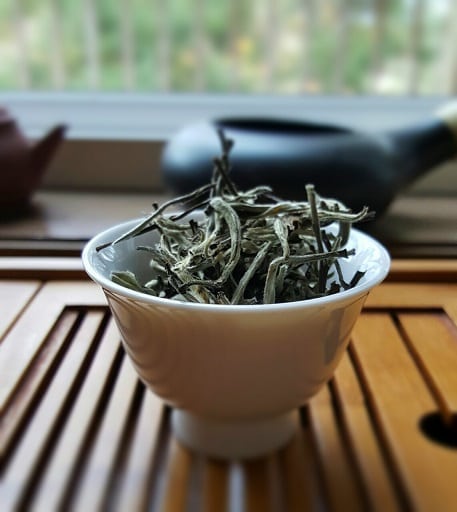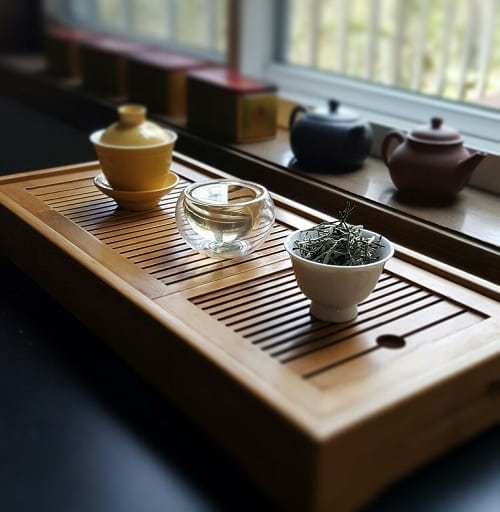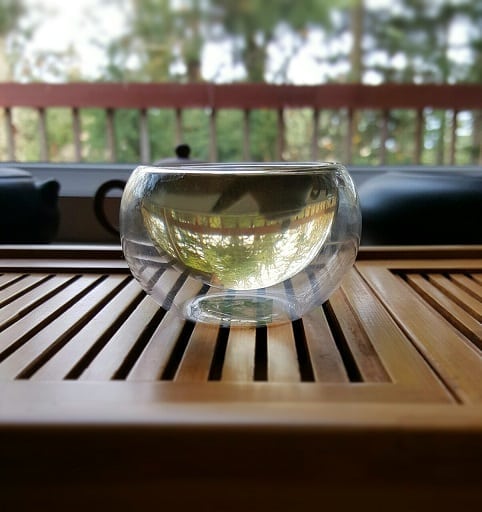This is a white tea called Doke Silver Needle.

I . . . may have written about it several times.
I know exactly where it comes from. (The Doke tea estate in Bihar, India.) I know who owns the estate. (Rajiv Lochan.) I know who makes it. (Rajiv’s daughter, Neha “Dolly” Lochan.) And I know who sells it directly to me. (Rajiv’s son, Vivek Lochan.) When brewed, the liquor is as transparent as the entire experience. I know just about everything I need to about this tea, and—each year—it continues to surprise me.
Lately, however, I realized I’ve taken this experience for granted. Knowing that much about a tea is an exception, not the norm. Compounded with that, I’m a tea blogger that specializes in telling stories about teas. So, painting a transparent picture of the tea experience is something I’m focused on. That is also far removed from the average tea drinker. It made me wonder . . . how important is transparency to the everyday cupper?
When I was first getting started with tea, I tried my first “Darjeeling” on a work shift. I use the word “Darjeeling” in quotes because it barely qualified. It was in a teabag—strike one. The leaves were dust—strike two. And it tasted like sawdust—strike three. On top of that, there was no additional information about the garden it came from, or what blend of gardens it was, or even what seasonal flushes the leaves were.
Granted, back then, I didn’t care for that much detail to what I was drinking. But when the time came to try a real Darjeeling—where I knew the estate, the season, the year, and the middle-man who provided it—I was blown away. Aside from it being a really good tea, the added information enriched my overall experience.
As the years went by—and the further I went down the tea rabbit-hole—I learned more. Unfortunately, that added knowledge also revealed a seedier side to the tea industry. I became aware of some shady practices. I found out that many of the air-quotes “Darjeelings” on the markets were only partially made from Darjeeling estate leaves. The rest came from Nepal.
The practice wasn’t limited to West Bengal, either. Taiwan also faced a similar problem. Many Dong Ding oolongs on the market weren’t actually from Dong Ding Mountain. Many of them came from outlying areas around Dong Ding. Either that, or—like Darjeelng—like-cultivar leaves from other regions were blended with the legit stuff, thus muddling the experience. Such practices were commonplace in Taiwan, China, and—heck—even Western countries. To make up for a lack of quantity, other product was brought in. And if/when that failed, there were knock-offs.
Places like Thailand and Vietnam created their own versions of proprietary Taiwanese oolongs. China started mimicking Japanese green tea processing techniques. Asia Major countries copycatted white teas. None of this was inherently bad as a whole, but in some shadier cases, such creations were passed off as the authentic regional stuff.
And puerh . . . *sigh* . . . I won’t even get into puerh.
In recent years, though, most wholesale distributors and vendors make it a point to label their teas correctly. If it’s a Bai Hao oolong from Vietnam or Thailand, they say so. If a Nepalese sencha, it’s labeled accordingly. Seasonal flush and year are also important info (if only to drive up the specialty price). But sellers are only willing to take transparency so far. Why?
In short; survival.
The world is growing increasingly smaller. People are more aware of where their products come from. Many like to know exactly what they’re getting themselves into. Some even going as far as contacting farmers directly. Or at the very least, having the farmer’s information readily available for perusal. That’s all well and good, but that presents its own set of challenges.
In some cases, the farmer doesn’t want to be known. Moreover, sometimes they don’t want to be profiled . . . or photographed . . . or even contacted, except by those whom they’ve developed a relationship with. Privacy is very important, and—while we’re on the subject—so is proprietorship.

I know of two instances where the desire for more transparency actually backfired. A vendor friend of mine did some business with a teashop, and the teashop owner—in turn—tried to contact their tea source directly. Behind their back. In another case, a vendor contact’s sole gardener had a profile show up on a tea website, and said farm was bombarded with inquiries. With no way to cope.
These are extreme cases, sure, but still very real.
Another sticky issue is certification. Allow me to illustrate this point with a fictional example: Say you’re a garden that has earned a special certification. We’ll call it . . . “Super Agro-Wizard”. Okay, you’re a garden that has earned a Super Agro-Wizard seal of approval. Said certification becomes the new “in” thing among the health nut set.
The problem? Your garden doesn’t produce enough tea to meet the demand of the Super Agro-Wizard fan-mob. So, you blend your Super Acro-Wizard leaves with leaves from non-certified estates to meet that demand. While “technically” not a Super Agro-Wizard product anymore, you can still advertise that a percentage of the product still pertains to that certification. And the consumer is none the wiser.
In this instance, the desire for full transparency backfires simply by way of wording. Not only that, but if the source of the ingredients in a product can’t be properly verified, it becomes difficult to import that product. Especially if the importing country has—say—certain stringent laws regarding these percentages and certification labels. (I’m looking at you, EU.)
At this point, one would probably throw their hands up in the air and yell, “Well, if we can’t have fully transparent nice things, is there a middle ground?!”
Good question, Todd. (Or Sheryl. Or whatever your name is.)
There is no easy answer. Full transparency has its own set of issues; just as no transparency does. To date, I have no clue if there even is a middle ground—or even what that’d look like. I suppose it all comes down to trust.
Do you trust the shop you bought your tea from? Do they trust their supplier? Does the supplier trust the factory that processed it? Does the factory owner trust the farmer they sourced from?
And, most importantly—as a consumer—do you really care?
I do . . . but then again, I’m a tea storyteller.

And I prefer my white tea liquor transparent.
Leave a Reply